Group of Quantum Optics (GOQ)
- Home
- Research
- DEQ - Department of Quantum Electronics
- Group of Quantum Optics (GOQ)
The research in the Group Quantum Optics while cmprise the foundations of quantum mechanics as well as the emerging technology applications related to them, such as quantum cryptography, quantum teleportation and quantum computing. Research is mostly theoretical, but the group has also made inroads in the experimental investigations.
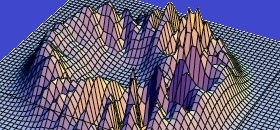
Quantum mechanics was created in the first quarter of the twentieth century to expand the physical theories at that time, which could not give account of several phenomena involving light, atoms and molecules. The result not only changed our understanding of the fundamentals of physics, but also our own basic notions about the microscopic universe.
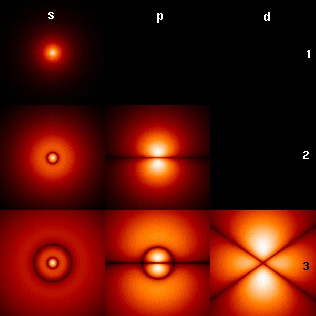
The electron orbitals of the hydrogen atom for various energies. The orbitals indicate the probability of finding an electron at each point (the brighter the region, the more likely to find an electron): quantum mechanics indicates only probabilities, not exact locations. The energy growths from top to bottom and from left to right. Source: Wikipedia.
In quantum theory, there seems to be an intrinsic indeterminism in nature (although the results based on the probabilistic theory are closer to the experimental measurements than those of classical physics). In addition, different physical states - a physical state is a "situation" in which an object can be found, as its position, its temperature and so on. - may be somewhat overlapped, combined to form a third different state. The theory has also shown that the notion of superposition of states can be extended to pairs of bodies, so that everything happens as if it was not possible to associate a physical state of each of them individually, but only to the pair as a whole - and it was only possible to change the state of the whole pair, not of each object separately (it is the "entanglement"). For people in general, these anti-intuitive features remained just as curious and fascinating abstractions until, in the 80s, began the developments of the theoretical bases for the technologies that depend crucially on them. Today, we talk about quantum computers, quantum cryptography, quantum teleportation, etc.
In general, these technologies (most still are in a very early stage) depend on two fundamental quantum phenomena, closely related to the anti-intuitive features described above: quantum superposition and quantum entanglement (the latter can be considered a kind of superposition involving two or more physical systems).
Contrarily to what may look like - a change in the entangled state by itself can not transmit information instantaneously through space.
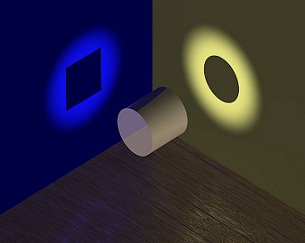
How can the same object manifest itself in two different ways without being any of them? The Wikipedia site has a very interesting idea to explain this, with the figure above, written by Jean-Christophe Benoist. Here, a cylinder produces a square shadow on a wall and circular shadow on another wall. If we see only the shadow - and mistakenly identify the shadow with the object itself – it would seem a contradiction: how can something be round and square at the same time?! But the object is not either a circle or a square: it is another entity (a cylinder), we were not looking directly - but that is manifested as a square or a circle depending on the situation. But beware: this is only an analogy. Both particles and waves as entities "either-no-wave-nor-particles" are common in three dimensional space. The correspondence is that, in physics, we can only measure the properties of “things”, we do not have access to the “things” themselves. Of course no one ever saw a computer in such a situation. It happens that this combination is more unstable the greater the mass of the object in question. Very small disturbances can transform them quickly in one of two superposed states, breaking the combination. The first superposition quantum states of position within an entire atom was only obtained only in 1996. Something of the size of a computer would "collapse" almost instantaneously to one of the states, on or off, long before it could be observed. This rapid evolution of a superposition of states towards the individual states, due to the minimum disturbances of the surrounding environment, constitutes what is called "loss of coherence" or “decoherence”.
Now, let's see what you can do with all this!
Quantum cryptography – This is actually a type of quantum distribution of secret keys, which can be used to encode and decode messages. The main difference between the quantum key distribution and the usual encryption systems is that it is possible to know if the communication between the parties is being intercepted, and thus nullify the action of a spy. This is related to the collapse of quantum states – superposition states or entangled, described above. In this case, the disturbance that causes the collapse is the action of the interceptor.
Note that in quantum cryptography, the generated secret keys are identical – a random sequence of 0s and 1s, which are held by the interlocutors - Alice and Bob. The keys will be available for encoding the message being sent (by Alice, for example) and decoding the received message (for Bob). This is done by transmitting signals - quantum states of light from Alice to Bob. Despite problems such as losses caused by the “real world” transmission methods – e.g., via fiber optics, quantum key distribution has been successfully accomplished over increasingly larger distances. The first protocol for quantum key distribution (BB84) was conceived in 1984 and the first demonstration in the laboratory was done in 1989.
Quantum teleportation – is a technique to transfer information from one place to another. That is, the quantum teleportation transmits no matter, just information. Moreover, it can not be transmitted at speeds greater than light. However, it can transmit all the information about physical states in a quantum superposition, which until 1993 no one knew how to do it without destroying the superposition. The teleportation also uses quantum entanglement - is at the time of its collapse that some information is transmitted from one location to another (taking advantage of the fact that the collapse happened in the state of the pair as a whole, regardless of the distance separating the interlocutors). But in order to turn transmitted information intelligible, additional information shall be communicated through conventional (classical) channels (so that you can not have data transmission at infinite speeds). Quantum teleportation was proposed in 1993 and has been demonstrated experimentally in 1997 for the first time.
Quantum computing – For some applications, a quantum computer would make calculations millions of times faster than an ordinary computer. For others, however, there is not much difference. Among the cases where it is much faster, is decoding messages encrypted by the method currently used in the internet (multiplication of prime numbers). That is, these computers could break most current encodings. Other cases are the data search in a disordered file and computer simulations of quantum complex systems.
In quantum computers, the information unit is not the bit, as in normal computing, but the qubit (pronounced "quiu-bit"). The difference is that a bit can have only two values - represented by, say, 0 and 1 -, while a qubit can assume the value 0, 1 or any of the infinite quantum superpositions of these two states. In addition, several qubits can be entangled with each other. Recall that an entangled state changes affect all qubits simultaneously. The two things together - the infinite superpositions with 0 and 1 and entanglement - can be used in some cases to dramatically increase the speed of processing.
The qubit can be physically implemented in several ways. You can implement qubits with energy states of atoms. Atom with lowest energy is the "0"; atom with higher energy is the "1". They may be entangled in various ways, e.g., by making them pass together through suitably arranged electromagnetic fields. Another example: the spin of a particle like the electron. Spin is a characteristic of the micro-particles world which has no counterpart in the macroscopic world, but that is very similar to a common rotation. Spin "spinning" to one side represents the "0" to the other, represents the "1".
The fight against the loss of coherence - Perhaps the biggest challenges for the scientific research in this area are in quantum computers. In this case (and in cryptography and quantum teleportation), one of the main problems is the extreme instability of superposed and entangled states. They can "collapse" to separable states due to perturbations of the environment – it is the process of decoherence. It is therefore necessary that quantum computers are able carry their operations before losing coherence, otherwise the computer will suffer the so-called "sudden death" (stops working during processing).
Moreover, the greater the number of entangled physical systems, in general the more unstable is the entanglement. Only in 1996 it was achieved in laboratory an entangled state of two atoms. Nowadays, it is possible to do so with trillions of atoms, but the entanglement is short lived and the system is not quite suitable for quantum computing.
To solve this, it is necessary not only to build a fast computer, but also slow down the loss of coherence. In order to do so, we need to know all the possible disturbances that may occur in the considered physical system and how they influence the loss of coherence.
Atoms in cavities – also must be taken into account that, depending on the way entanglement is generated and how the qubit is implemented - with electrons, photons, or atoms – we may have more or less robustness against loss of coherence. In our group research in mainly based on atomic qubits, which may be entangled by means of electromagnetic fields confined in highly reflective cavities (cavity QED). The energy states of the atom contain the information "0" or "1".
Another very interesting system that has been studied in our group is called the optomechanical oscillator - tiny membranes may have its motion controlled so that they become "quantum objects" - subject to the laws of quantum mechanics, and therefore with the possibility form of quantum superpositions and entangled states with objects containing many atoms, almost macroscopic.
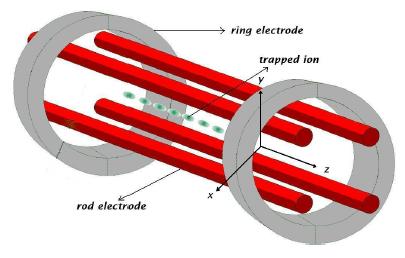
(Figure 1) - Scheme of a trap for atoms using electromagnetic fields to confine ions (atoms without some electrons and therefore electrically charged that can be "trapped" by electric and magnetic fields)
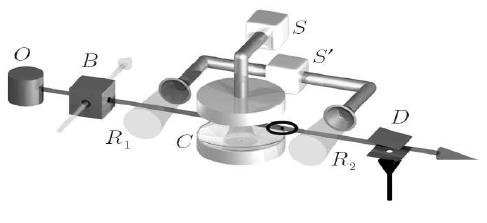
(Figure2)
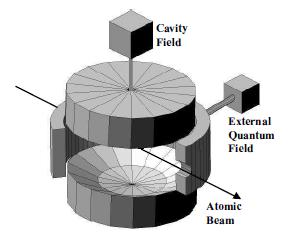
(Figure 3)
In Figure 2 and 3: Scheme of two optical cavities crossed by a flying atom
Sources: J.M. Raimond, T. Meunier, P. Bertet, S. Gleyzes, P. Maioli, A. Auffeves, G. Nogues, M. Brune and S. Haroche, Probing a quantum field in a photon box, J. Phys. B: At. Mol. Opt. Phys. 38, S535 (2005); Master thesis of Fernando Luís Semião da Silva, IFGW/Unicamp (2002), p. 10. Doctoral thesis of Fabiano Kenji Nohama, IFGW/Unicamp (2008), p. 41. Master thesis of Ricardo José Missori, IFGW/Unicamp (2003), p. 46.
The atoms can be entangled after passing through QED cavities arranged in an appropriate manner, as shown below. Several possibilities have been studied, including cavities connected by optical fibers, since there should be some communication between qubits at different locations in the circuit of a quantum computer.

Scheme of an apparatus to entangle energy states of two atoms. In the left and right are shown two QED cavities. Within each one an atom is enclosed (in blue). The interaction between atoms and the electromagnetic fields inside the cavities produces two photons in each one, which follow the dashed path until the photon detectors D1 and D2. In the middle of that path there is a semitransparent mirror (BS) that entangles the two photons. This mirror and the detectors are able to prepare, under certain circumstances, the two atoms and the two fields within the cavities in entangled states. Note that the two cavities are separated; the entanglement can be obtained even when the atoms are far apart.
Source: Master thesis of Bruno Ferreira de Camargo Yabu-uti, IFGW / UNICAMP (2007), p. 36.
The rate of loss of coherence also depends on the type of generated entanglement. Our Quantum Optics Group, for example, proposed in 2007 a new type of entangled state, called " cluster type entangled coherent state" (CTECS), whose advantage is just its robustness against the influence of environment. The CTECS fall into the category of entangled states with continuous variables, in contrast to states with discrete variables. The difference is that the discrete state variables are characterized by only certain specific energies (the energy is quantized), whereas continuous variables may be in a range of continuously varying energy values. For example, the laser light source represents a continuous variable state easy to implement and handle. It also investigated how to transfer data from discrete variables entangled states to continuous variables and vice versa, as well as protocols for quantum cryptography using continuous variables.
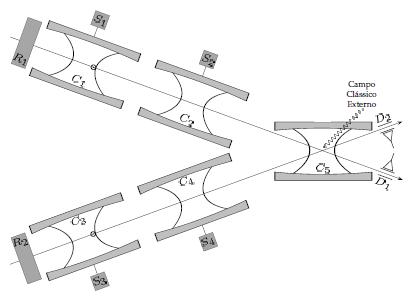
Experimental apparatus proposed by the Group to make the entangled state CTECS. The scheme uses strategically placed QED cavities so that two atoms cross the cavities and generate entangled CTECS in them.
Source: PhD thesis of Parmezani Pablo Munhoz, IFGW / UNICAMP (2008), p. 40.
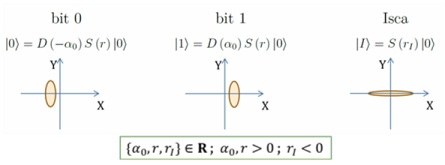
A set of squeezed states of light to be used in an alternative protocol quantum key distribution. Two distinct states are used to encode the bits 0 and 1 while a third state "decoy" is used to confuse a possible spy.
Source: Master thesis of Douglas Delgado de Souza, IFGW / UNICAMP (2011), p. 100.
It is important to emphasize that our Group investigates not only the practical possibilities of implementing the new quantum technologies, but also the foundations of quantum mechanics, for a better understanding of the extraordinary nature of quantum states and their relation to the macroscopic world.
The Group began with the researche of José Antonio Roversi while he was still in the Group of Phase Transitions in the IFGW, led by prof. Paulo Roberto de Paula e Silva. With the arrival of Antonio Vidiella Barranco, the Quantum Optics group was formally constituted. In the beginning, it was studied methods of generation of quantum states (entangled or not) from the theoretical point of view. Later, they began to work also with quantum cryptography, as well as in the investigation of the physical implementation of the entangled states, mainly in atoms in optical cavities, trapped ions and in optomechanical systems.
Universidade Estadual de Campinas - Instituto de Física Gleb Wataghin
Rua Sérgio Buarque de Holanda, 777
Cidade Universitária, Campinas - SP, 13083-859
Fone +55 19 3521-5297
Fax +55 19 3521-4147